
 This page highlights items in the Earlham Libraries' collection related to racial justice in the United States and the Black Lives Matter movement. This display is co-sponsored by Earlham's Diversity Progress Committee, which helped curate selections and provided generous funding for new purchases. Suggestions are welcomed. Please contact a librarian if you have additional materials to recommend.
This page highlights items in the Earlham Libraries' collection related to racial justice in the United States and the Black Lives Matter movement. This display is co-sponsored by Earlham's Diversity Progress Committee, which helped curate selections and provided generous funding for new purchases. Suggestions are welcomed. Please contact a librarian if you have additional materials to recommend.
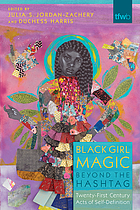 Black Girl Magic Beyond the Hashtag
by
Hashtag or trademark, personal or collective expression, #BlackGirlMagic is an articulation of the resolve of Black women and girls to triumph in the face of structural oppressions. The online life of #BlackGirlMagic insists on the visibility of Black women and girls as aspirational figures. But while the notion of Black girl magic spreads in cyberspace, the question remains: how is Black girl magic experienced offline? The essays in this volume move us beyond social media. They offer critical analyses and representations of the multiplicities of Black femmes', girls', and women's lived experiences. Together the chapters demonstrate how Black girl magic is embodied by four elements enacted both on- and offline: building community, challenging dehumanizing representations, increasing visibility, and offering restorative justice for violence. Black Girl Magic Beyond the Hashtag shows how Black girls and women foster community, counter invisibility, engage in restorative acts, and create spaces for freedom. Intersectional and interdisciplinary, the contributions in this volume bridge generations and collectively push the boundaries of Black feminist thought.
Black Girl Magic Beyond the Hashtag
by
Hashtag or trademark, personal or collective expression, #BlackGirlMagic is an articulation of the resolve of Black women and girls to triumph in the face of structural oppressions. The online life of #BlackGirlMagic insists on the visibility of Black women and girls as aspirational figures. But while the notion of Black girl magic spreads in cyberspace, the question remains: how is Black girl magic experienced offline? The essays in this volume move us beyond social media. They offer critical analyses and representations of the multiplicities of Black femmes', girls', and women's lived experiences. Together the chapters demonstrate how Black girl magic is embodied by four elements enacted both on- and offline: building community, challenging dehumanizing representations, increasing visibility, and offering restorative justice for violence. Black Girl Magic Beyond the Hashtag shows how Black girls and women foster community, counter invisibility, engage in restorative acts, and create spaces for freedom. Intersectional and interdisciplinary, the contributions in this volume bridge generations and collectively push the boundaries of Black feminist thought.
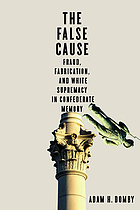 The False Cause: Fraud, Fabrication, and White Supremacy in Confederate Memory
by
The Lost Cause ideology that emerged after the Civil War and flourished in the early twentieth century in essence sought to recast a struggle to perpetuate slavery as a heroic defense of the South. As Adam Domby reveals here, this was not only an insidious goal; it was founded on falsehoods. The False Cause focuses on North Carolina to examine the role of lies and exaggeration in the creation of the Lost Cause narrative. In the process the book shows how these lies have long obscured the past and been used to buttress white supremacy in ways that resonate to this day. Domby explores how fabricated narratives about the war's cause, Reconstruction, and slavery--as expounded at monument dedications and political rallies--were crucial to Jim Crow. He questions the persistent myth of the Confederate army as one of history's greatest, revealing a convenient disregard of deserters, dissent, and Unionism, and exposes how pension fraud facilitated a myth of unwavering support of the Confederacy among nearly all white Southerners. Domby shows how the dubious concept of "black Confederates" was spun from a small number of elderly and indigent African American North Carolinians who got pensions by presenting themselves as "loyal slaves." The book concludes with a penetrating examination of how the Lost Cause narrative and the lies on which it is based continue to haunt the country today and still work to maintain racial inequality.
The False Cause: Fraud, Fabrication, and White Supremacy in Confederate Memory
by
The Lost Cause ideology that emerged after the Civil War and flourished in the early twentieth century in essence sought to recast a struggle to perpetuate slavery as a heroic defense of the South. As Adam Domby reveals here, this was not only an insidious goal; it was founded on falsehoods. The False Cause focuses on North Carolina to examine the role of lies and exaggeration in the creation of the Lost Cause narrative. In the process the book shows how these lies have long obscured the past and been used to buttress white supremacy in ways that resonate to this day. Domby explores how fabricated narratives about the war's cause, Reconstruction, and slavery--as expounded at monument dedications and political rallies--were crucial to Jim Crow. He questions the persistent myth of the Confederate army as one of history's greatest, revealing a convenient disregard of deserters, dissent, and Unionism, and exposes how pension fraud facilitated a myth of unwavering support of the Confederacy among nearly all white Southerners. Domby shows how the dubious concept of "black Confederates" was spun from a small number of elderly and indigent African American North Carolinians who got pensions by presenting themselves as "loyal slaves." The book concludes with a penetrating examination of how the Lost Cause narrative and the lies on which it is based continue to haunt the country today and still work to maintain racial inequality.
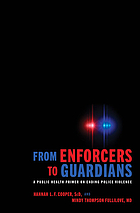 From Enforcers to Guardians
by
Excessive police violence and its disproportionate targeting of minority communities has existed in the United States since police forces first formed in the colonial period. A personal tragedy for its victims, for the people who love them, and for their broader communities, excessive police violence is also a profound violation of human and civil rights. Most public discourse about excessive police violence focuses, understandably, on the horrors of civilian deaths. In From Enforcers to Guardians, Hannah L. F. Cooper and Mindy Thompson Fullilove approach the issue from a radically different angle: as a public health problem. By using a public health framing, this book challenges readers to recognize that the suffering created by excessive police violence extends far outside of death to include sexual, psychological, neglectful, and nonfatal physical violence as well. Arguing that excessive police violence has been deliberately used to marginalize working-class and minority communities, Cooper and Fullilove describe what we know about the history, distribution, and health impacts of police violence, from slave patrols in colonial times to war on drugs policing in the present-day United States. Finally, the book surveys efforts, including Barack Obama's 2015 creation of the Task Force on 21st Century Policing, to eliminate police violence, and proposes a multisystem, multilevel strategy to end marginality and police violence and to achieve guardian policing. Aimed at anyone seeking to understand the causes and distributions of excessive police violence--and to develop interventions to end it--From Enforcers to Guardians frames excessive police violence so that it can be understood, researched, and taught about through a public health lens.
From Enforcers to Guardians
by
Excessive police violence and its disproportionate targeting of minority communities has existed in the United States since police forces first formed in the colonial period. A personal tragedy for its victims, for the people who love them, and for their broader communities, excessive police violence is also a profound violation of human and civil rights. Most public discourse about excessive police violence focuses, understandably, on the horrors of civilian deaths. In From Enforcers to Guardians, Hannah L. F. Cooper and Mindy Thompson Fullilove approach the issue from a radically different angle: as a public health problem. By using a public health framing, this book challenges readers to recognize that the suffering created by excessive police violence extends far outside of death to include sexual, psychological, neglectful, and nonfatal physical violence as well. Arguing that excessive police violence has been deliberately used to marginalize working-class and minority communities, Cooper and Fullilove describe what we know about the history, distribution, and health impacts of police violence, from slave patrols in colonial times to war on drugs policing in the present-day United States. Finally, the book surveys efforts, including Barack Obama's 2015 creation of the Task Force on 21st Century Policing, to eliminate police violence, and proposes a multisystem, multilevel strategy to end marginality and police violence and to achieve guardian policing. Aimed at anyone seeking to understand the causes and distributions of excessive police violence--and to develop interventions to end it--From Enforcers to Guardians frames excessive police violence so that it can be understood, researched, and taught about through a public health lens.
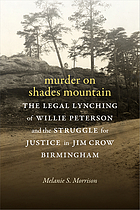 Murder on Shades Mountain
by
One August night in 1931, on a secluded mountain ridge overlooking Birmingham, Alabama, three young white women were brutally attacked. The sole survivor, Nell Williams, age eighteen, said a black man had held the women captive for four hours before shooting them and disappearing into the woods. That same night, a reign of terror was unleashed on Birmingham's black community: black businesses were set ablaze, posses of armed white men roamed the streets, and dozens of black men were arrested in the largest manhunt in Jefferson County history. Weeks later, Nell identified Willie Peterson as the attacker who killed her sister Augusta and their friend Jennie Wood. With the exception of being black, Peterson bore little resemblance to the description Nell gave the police. An all-white jury convicted Peterson of murder and sentenced him to death. In Murder on Shades Mountain Melanie S. Morrison tells the gripping and tragic story of the attack and its aftermath--events that shook Birmingham to its core. Having first heard the story from her father--who dated Nell's youngest sister when he was a teenager--Morrison scoured the historical archives and documented the black-led campaigns that sought to overturn Peterson's unjust conviction, spearheaded by the NAACP and the Communist Party. The travesty of justice suffered by Peterson reveals how the judicial system could function as a lynch mob in the Jim Crow South. Murder on Shades Mountain also sheds new light on the struggle for justice in Depression-era Birmingham. This riveting narrative is a testament to the courageous predecessors of present-day movements that demand an end to racial profiling, police brutality, and the criminalization of black men.
Murder on Shades Mountain
by
One August night in 1931, on a secluded mountain ridge overlooking Birmingham, Alabama, three young white women were brutally attacked. The sole survivor, Nell Williams, age eighteen, said a black man had held the women captive for four hours before shooting them and disappearing into the woods. That same night, a reign of terror was unleashed on Birmingham's black community: black businesses were set ablaze, posses of armed white men roamed the streets, and dozens of black men were arrested in the largest manhunt in Jefferson County history. Weeks later, Nell identified Willie Peterson as the attacker who killed her sister Augusta and their friend Jennie Wood. With the exception of being black, Peterson bore little resemblance to the description Nell gave the police. An all-white jury convicted Peterson of murder and sentenced him to death. In Murder on Shades Mountain Melanie S. Morrison tells the gripping and tragic story of the attack and its aftermath--events that shook Birmingham to its core. Having first heard the story from her father--who dated Nell's youngest sister when he was a teenager--Morrison scoured the historical archives and documented the black-led campaigns that sought to overturn Peterson's unjust conviction, spearheaded by the NAACP and the Communist Party. The travesty of justice suffered by Peterson reveals how the judicial system could function as a lynch mob in the Jim Crow South. Murder on Shades Mountain also sheds new light on the struggle for justice in Depression-era Birmingham. This riveting narrative is a testament to the courageous predecessors of present-day movements that demand an end to racial profiling, police brutality, and the criminalization of black men.
 Violence Work
by
In Violence Work Micol Seigel offers a new theorization of the quintessential incarnation of state power: the police. Foregrounding the interdependence of policing, the state, and global capital, Seigel redefines policing as "violence work," showing how it is shaped by its role of channeling state violence. She traces this dynamic by examining the formation, demise, and aftermath of the U.S. State Department's Office of Public Safety (OPS), which between 1962 and 1974 specialized in training police forces internationally. Officially a civilian agency, the OPS grew and operated in military and counterinsurgency realms in ways that transgressed the borders that are meant to contain the police within civilian, public, and local spheres. Tracing the career paths of OPS agents after their agency closed, Seigel shows how police practices writ large are rooted in violence--especially against people of color, the poor, and working people--and how understanding police as a civilian, public, and local institution legitimizes state violence while preserving the myth of state benevolence.
Violence Work
by
In Violence Work Micol Seigel offers a new theorization of the quintessential incarnation of state power: the police. Foregrounding the interdependence of policing, the state, and global capital, Seigel redefines policing as "violence work," showing how it is shaped by its role of channeling state violence. She traces this dynamic by examining the formation, demise, and aftermath of the U.S. State Department's Office of Public Safety (OPS), which between 1962 and 1974 specialized in training police forces internationally. Officially a civilian agency, the OPS grew and operated in military and counterinsurgency realms in ways that transgressed the borders that are meant to contain the police within civilian, public, and local spheres. Tracing the career paths of OPS agents after their agency closed, Seigel shows how police practices writ large are rooted in violence--especially against people of color, the poor, and working people--and how understanding police as a civilian, public, and local institution legitimizes state violence while preserving the myth of state benevolence.
Earlham Libraries provide access to many streaming feature films and documentaries. These titles can be found by searching the library catalog. Kanopy provides a list of several titles regarding Social and Systemic Injustice. Two titles listed below.

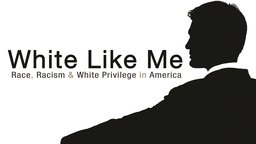
Earlham College • 801 National Road West • Richmond, Indiana 47374-4095